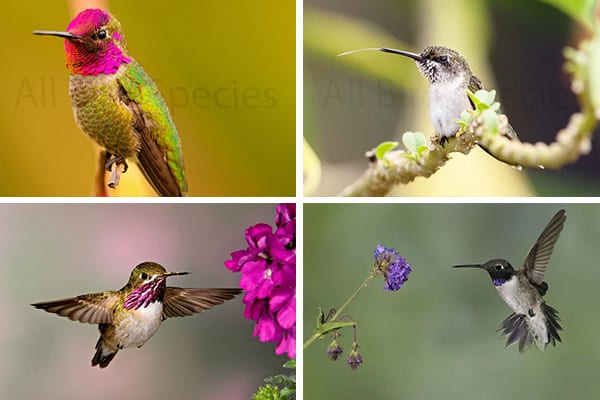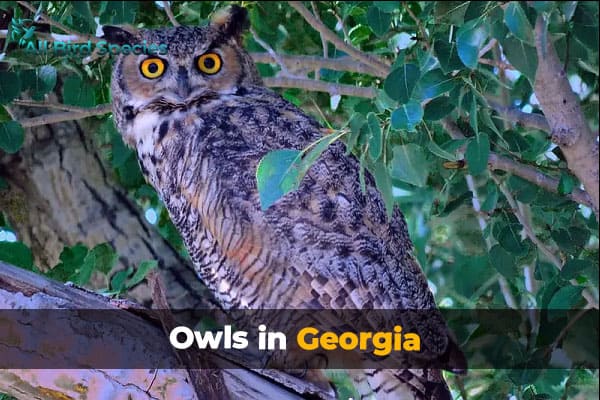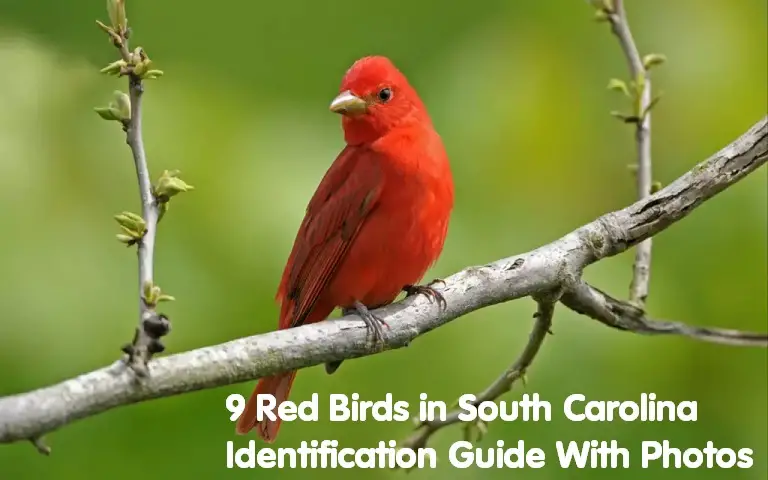5 Types of Hummingbirds in Maryland (With Pictures)
When you think of Maryland, you might not immediately think of hummingbirds. However, this vibrant state is home to a surprising variety of these tiny, energetic birds, making it a prime spot to spot hummingbirds. From the iconic ruby-throated hummingbird to the rare Calliope hummingbird, a species known to see hummingbirds in Maryland during their migration period., each species brings its unique beauty and charm to Maryland’s natural landscapes.
In this article, we will delve into the world of hummingbirds in Maryland, exploring the characteristics and habitats of the five different species found in the state. Get ready to be amazed by the incredible diversity of these feathered jewels!
Key Takeaways:
- Maryland is home to five different species of hummingbirds.
- The ruby-throated hummingbird is the most common species found in Maryland.
- The black-chinned hummingbird is a less common species but can still be seen during migration.
- The calliope hummingbird is a rare visitor to Maryland.
- The rufous hummingbird can be found in Maryland during migration.
1. Ruby-throated hummingbird
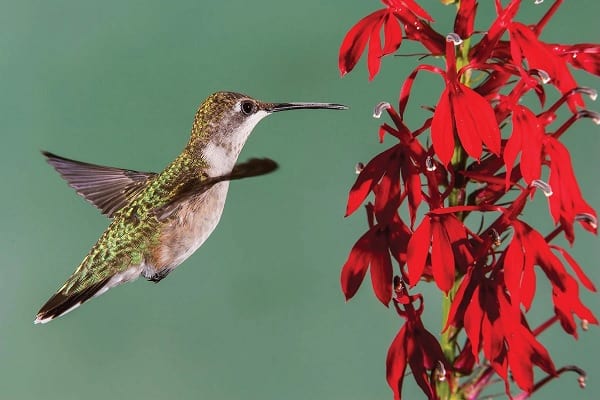
The ruby-throated hummingbird is the most common species found in Maryland. These birds are known for their vibrant green feathers and the iconic red throat of the males.
During their annual migration, ruby-throated hummingbirds arrive in Maryland during the week of May. As they make their way north from their wintering grounds in Central America, these tiny birds rely on the abundance of nectar and insects found along their migratory route.
To attract ruby-throated hummingbirds to your garden, provide them with a reliable food source. Feeders filled with sugary nectar are an excellent option. You can also create a hummingbird-friendly habitat by planting a variety of nectar-rich flowers, such as trumpet vine, bee balm, and cardinal flower.
If you’re lucky enough to spot a ruby-throated hummingbird in your garden, observe their impressive hovering flight and delicate feeding behavior. It’s a truly remarkable experience to witness these beautiful creatures up close.
Did you know? The ruby-throated hummingbird is the only hummingbird species that breeds regularly in eastern North America.
| Characteristic of hummingbirds are their vibrant colors and rapid flight, which attract hummingbirds enthusiasts. | Ruby-Throated Hummingbird |
|---|---|
| Size | About 3 to 3.7 inches (7.6 to 9.4 cm) in length |
| Feathers | Vibrant green feathers on their back and white on their belly |
| Throat | Males have a vibrant red throat while females have a white throat |
| Migratory Pattern | Arrive in Maryland during the week of May and return to their wintering grounds in Central America in fall |
| Food | Feed primarily on nectar from flowers and sugar water from feeders |
2. Black-Chinned Hummingbird
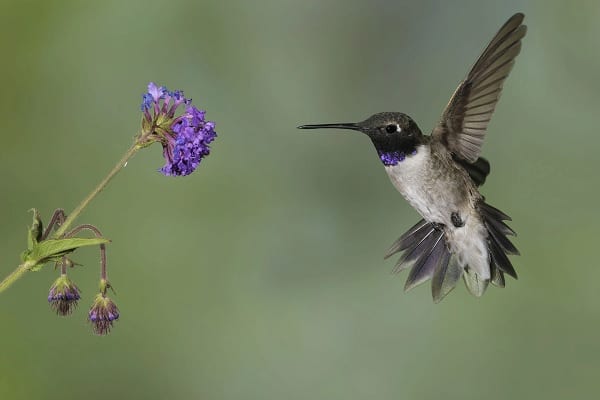
The black-chinned hummingbird is a captivating species of hummingbird that can be found in Maryland during its migration. While not as common as other hummingbird species in the area, they are still a sight to behold with their iridescent green feathers and distinctive black chin. These tiny birds have a unique migration pattern that sets them apart from other hummingbirds.
One of the defining characteristics of the black-chinned hummingbird is its preference for tubular flowers, such as the trumpet creeper. These flowers provide a perfect source of nectar for these birds, allowing them to refuel during their long journey. Their specialized beak shape enables them to extract nectar from these tubular flowers with ease.
During migration, the black-chinned hummingbird showcases its remarkable ability to navigate vast distances. They embark on a long journey from their breeding grounds in the western United States and Mexico, exemplifying how hummingbirds Hummingbirds migrate thousands of miles, with some species moving from Central America to as far north as Canada. over vast distances. wintering grounds in Central America. This migration is a testament to the black-chinned hummingbird’s endurance and adaptability.
“The black-chinned hummingbird’s migration patterns are truly fascinating. These remarkable birds can travel up to 2,000 miles during their annual journey, relying on their highly efficient metabolisms to sustain them throughout the long flight.”
If you’re lucky enough to spot a black-chinned hummingbird in Maryland, take a moment to appreciate the beauty and resilience of these stunning creatures. Their presence is a testament to the remarkable journeys that hummingbirds undertake and the natural wonders that surround us
Also Read Small Green Birds in Florida
3. Calliope Hummingbird
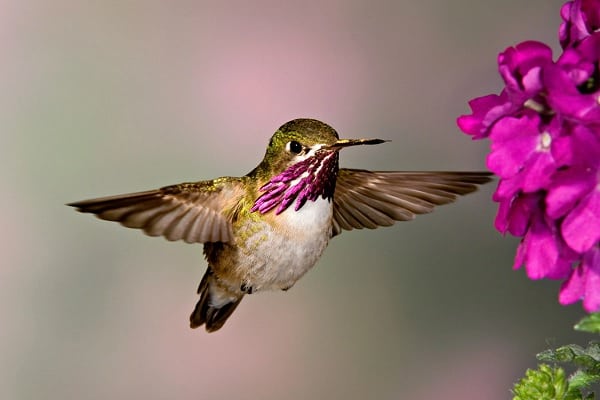
The calliope hummingbird, a rare visitor to Maryland, is a small bird known for its unique beak shape and bright pink throat. While this species is more commonly found in the western United States, they occasionally make appearances in Maryland, adding to the fascinating variety of hummingbirds in the state.
The calliope hummingbird, one of the smallest bird species in North America, measures only about 3.5 inches in length. Its beak is long and thin, specially adapted for reaching deep into flowers to extract nectar. This species also has a distinctive, high-pitched chirping call that adds to its charm and makes it easier to spot hummingbirds by their sounds.
Male calliope hummingbirds have beautiful iridescent green feathers, with a white belly and a gorget (throat patch) that can range in color from bright pink to purple. These vibrant colors are used to attract females and establish territory during breeding season.
While calliope hummingbirds primarily breed and nest in the western part of the United States, their migration patterns occasionally bring them to Maryland. These birds can be spotted in forests, meadows, and gardens, particularly during the spring and summer months.
If you are lucky enough to catch a glimpse of a calliope hummingbird in Maryland, consider yourself fortunate. To increase your chances of spotting one, set up a hummingbird feeder With a sugar-water solution in nectar feeders, you can easily attract hummingbirds to your garden, providing them with the energy they need during migration.. Place the feeder in a visible and accessible location, and keep an eye out for these beautiful and elusive visitors.
Also visit Common Spiders in California
Calliope Hummingbird Quick Facts
- Scientific Name: Selasphorus calliope
- Average Length: Approximately 3.5 inches
- Beak Shape: Long and thin, adapted for reaching into flowers
- Male Coloration: Iridescent green feathers, white belly, and a bright pink to purple throat patch
- Habitat: Forests, meadows, gardens, and areas with nectar feeders designed to attract hummingbirds.
- Migratory Pattern: Occasionally visit Maryland during migration
- Attracting Technique: Set up a hummingbird feeder with a sugar-water solution
| Species | Length | Beak Shape | Male Coloration | Habitat | Migratory Pattern | Attracting Technique |
|---|---|---|---|---|---|---|
| Calliope Hummingbird | Approximately 3.5 inches | Long and thin, adapted for reaching into flowers | Iridescent green feathers, white belly, and a bright pink to purple throat patch | Forests, meadows, gardens | Occasionally visit Maryland during migration | Set up a hummingbird feeder with a sugar-water solution |
4. Rufous Hummingbird
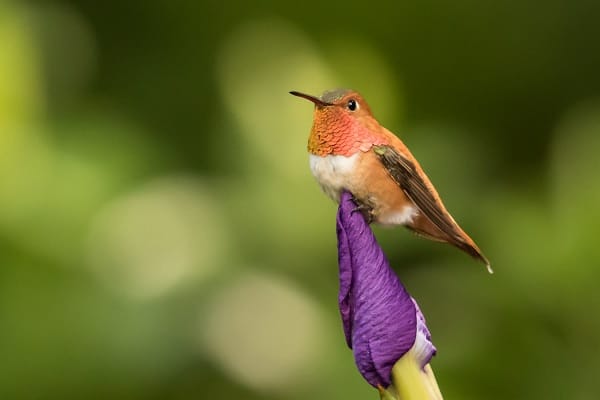
The rufous hummingbird is a fascinating species that can be found in Maryland, especially during their migration. These tiny birds are known for their stunning fiery Orange-red, a color often associated with the male ruby-throated hummingbird, which can be spotted in Maryland during their migration. Feathers, which make them a dazzling sight in any garden or natural setting, especially those with nectar feeders to attract hummingbirds. They belong to the hummingbird family, which is renowned for its diversity, agility, and vibrant plumage.
One of the most remarkable features of the rufous hummingbird is its ability to perform breathtaking dives. During their courtship displays, male rufous hummingbirds execute a series of high-speed, acrobatic dives, reaching incredible speeds of up to 60 miles per hour. These dives are mesmerizing to witness and create a captivating spectacle in the sky.
The breeding season is a crucial time for the rufous hummingbird. Males vigorously defend their territories, engaging in fierce aerial battles with rival males to attract a mate. During this period, the male’s fiery colors become even more intense, adding to the visual spectacle of their courtship displays.
Breeding Rituals
The breeding rituals of the rufous hummingbird are intricate and fascinating. Once the males have secured their territories, they perform elaborate aerial displays, swooping and darting through the air in a mesmerizing dance. These displays showcase their agility, speed, and colorful feathers, all of which are aimed at impressing the females and securing a mate.
“Watching male rufous hummingbirds in their breeding season is a true delight. Their breathtaking dives and vibrant colors create a captivating display that highlights the incredible beauty of nature.” – Maryland Birdwatcher Club
During the breeding season, female rufous hummingbirds construct intricate nests using plant fibers, lichen, and spider silk. These nests are typically positioned on branches high above the ground, providing protection from predators. Once the nest is complete, the female lays two tiny eggs, each about the size of a jelly bean.
As their breeding season comes to an end, these remarkable birds continue their journey, migrating to their wintering grounds in Mexico and Central America. It’s an incredible feat for such a small creature, considering the long distances they travel.
| Rufous Hummingbird | Characteristics |
|---|---|
| Scientific Name | Selasphorus rufus |
| Size | 3-4 inches (7.5-10 cm) |
| Wingspan | 4-5 inches (10-13 cm) |
| Weight | 0.1-0.3 ounces (2-8 grams), the weight range of these remarkable birds, including the male ruby-throated and archilochus colubris species. |
| Habitat | Forests, mountains, gardens |
| Migration | Summer breeder in northern North America, winter in Mexico and Central America |
The rufous hummingbird’s beautiful plumage, incredible diving displays, and remarkable breeding rituals make it a captivating species to observe and admire.
You might be interested to read Why Chickens in Key West?
5. Anna’s Hummingbird

Anna’s hummingbird is a fascinating species that can be found in Maryland year-round, particularly in the central and western regions. These beautiful birds boast vibrant metallic green feathers, which shimmer in the sunlight and make them truly eye-catching. However, it’s the males that truly stand out with their vibrant orange-red throats, adding a splash of color to their appearance.
Unlike many other hummingbird species, Anna’s hummingbirds do not typically migrate. Instead, they remain in Maryland throughout the year, making them a constant presence in the state’s hummingbird community. They have adapted to the local climate and can withstand cold temperatures, even in winter. It’s truly a delight to witness these resilient birds in their wintering grounds.
Observing Anna’s hummingbirds in Maryland provides a unique opportunity to learn about their behaviors and habits. They are highly active birds, constantly flitting from flower to flower in search of nectar. You can create a hummingbird-friendly environment in your backyard by planting native flowers and providing a hummingbird feeder filled with fresh sugar water.
So, if you are in Maryland and want to catch a glimpse of these captivating creatures, keep an eye out for Anna’s hummingbirds. Their year-round presence, striking orange-red throats, and bustling activity are sure to leave you in awe.
Frequently Asked Questions
Q1: What months are hummingbirds in Maryland?
Hummingbirds typically arrive in Maryland around late April to early May and stay until late September to early October.
Q2: Where can I see hummingbirds in Maryland?
You can spot hummingbirds in gardens, parks, and wooded areas throughout Maryland, particularly where there are flowers and feeders.
Q3: Do hummingbirds live in MD?
Yes, hummingbirds do live in Maryland, especially during their breeding season in the warmer months.
Q4: Are there hummingbirds in DC?
Yes, hummingbirds can be found in Washington, D.C., especially during their migration periods and breeding season.
Q5: What month do you see the most hummingbirds?
The peak months for seeing hummingbirds in Maryland are typically May through August, with June and July often being the months with the highest activity levels.

